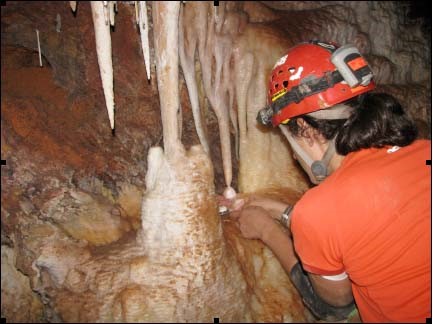The North American (paleo)monsoon: What can the last few thousand years tell us about our future?
The monsoon is in full swing here in Tucson! Unfortunately, compared to the last two summers, this monsoon is looking somewhat better, but not by much (see recent CLIMAS report). This begs the question: is there any chance we could depend on the monsoon to help alleviate some winter water shortages in the future as global climate changes?
In an earlier post, I focused on how and why climate models are not able to project monsoon rainfall reliably into the future. Luckily, we can use records of past climate to tell us about how the monsoon behaves when temperatures are warmer or colder, or when the sun’s energy input to the earth was greater or smaller, or more variable year-round. This use of “paleomonsoon” records will allow us to understand monsoon dynamics in such a way as to help climate modelers do the best job they can at predicting the monsoon.
There are a number of different records of the paleomonsoon, each of which records monsoon rainfall in a different way. Jess Conroy previously posted on tree rings as a source of information on past monsoon variation. However, tree-ring records tend to cover only the last 1,000-2,000 years, meaning that they might not be ideal for understanding monsoon behavior when climate is substantially different from modern climate. As global climate changes, we want to be able to understand regional/monsoon responses to that change. As a result, having longer records of monsoon variability, which cover time intervals in the past when global climate was substantially warmer, will help us predict monsoon response to future warming. That said, tree rings are definitely one bit of the paleomonsoon puzzle that we are rapidly piecing together.
Another example of a monsoon record actually comes from packrat middens. Although we know these rodents as hoarders of shiny objects and children’s toys, packrats also hoard small pieces of plants, which are sequestered in their crystallized urine for many thousands of years. Researchers such as Julio Betancourt and others at UA (papers here and here) have shown that packrats were collecting vegetation that normally grows only during the monsoon even during the last glacial era. This suggests that the monsoon was present in our area through the last 15,000 years and even farther in the past. However, this particular record of the paleomonsoon is somewhat discontinuous, and doesn’t give us much information about how the monsoon varies on multi-year, multi-decade, or multi-century scales, which complicates decision-making by water resource managers.
Although one rarely thinks of lakes in the desert Southwest, a few have existed here over the last few thousand years, and these lakes can serve as paleomonsoon archives as well. One such record is from northern Chihuahua, Mexico, where researchers from UNM-Albuquerque (Peter Castiglia and Peter Fawcett – article here) have used lakeshore deposits to reconstruct past lake levels. Their results show high lake levels from 8,400-8,200 years ago, 6,800-6,100 years ago, and 4,200-3,800 years ago. This, with other lake records from the monsoon area, suggests that the lakes were bigger and wetter thousands of years ago and have dried up in the more recent past. Were those lakes the result of a stronger monsoon? More work is needed to answer that question.

As a graduate student at UA, I use a different kind of deposit to look at past monsoon variations – cave stalagmites. Stalagmites form on the cave floor through the gradual dripping action of water. In southern Arizona, our monsoon rain looks chemically (isotopically) different from winter rain. Rainwater from the surface percolates through limestone, picks up some chemical constituents of that limestone, and flows to the cave environment, where those chemical constituents are recombined into calcium carbonate cave formations. This process actually preserves the original chemical (isotopic) signature of the rainfall. Because cave formations can be precisely dated using small amounts of uranium preserved in their structure, we can reconstruct the rain chemistry at precise times in the past. That is, I can tell if there was more or less monsoon rain relative to winter rain over the last many thousand years from the changes in the chemistry of stalagmites. As yet there are no published records of rainfall from our monsoon as recorded by stalagmites over the past few thousand years, but I hope to produce the first one as a part of my graduate research. In conjunction with these other types of records, cave records have the potential to produce very precise reconstructions of monsoon rainfall, elucidating the nature of year-to-year and decade-to-decade monsoon variability over the past many thousand years.
These are just a few examples of how we learn about the paleomonsoon. When the jigsaw puzzle is fitted together, different records seem to suggest a similar story. The bottom line: The summer monsoon may have been stronger a few thousand years ago, when the sun’s radiative input to the earth was weaker during winter and stronger during summer. But, we still aren’t sure if the monsoon was stronger in all areas across the Southwest, or if it covered a larger area, or precisely when it was stronger or weaker. Understanding monsoon variability as it relates to larger-scale processes, like changes in earth’s energy budget, or variations in sea-surface temperature patterns, or warmer climate conditions, etc, will allow us to understand what we might expect to see from the our monsoon in the future. It will also help us develop better models of monsoon dynamics. This is an area of active research, so stay tuned as we continue unearthing the puzzle pieces!

